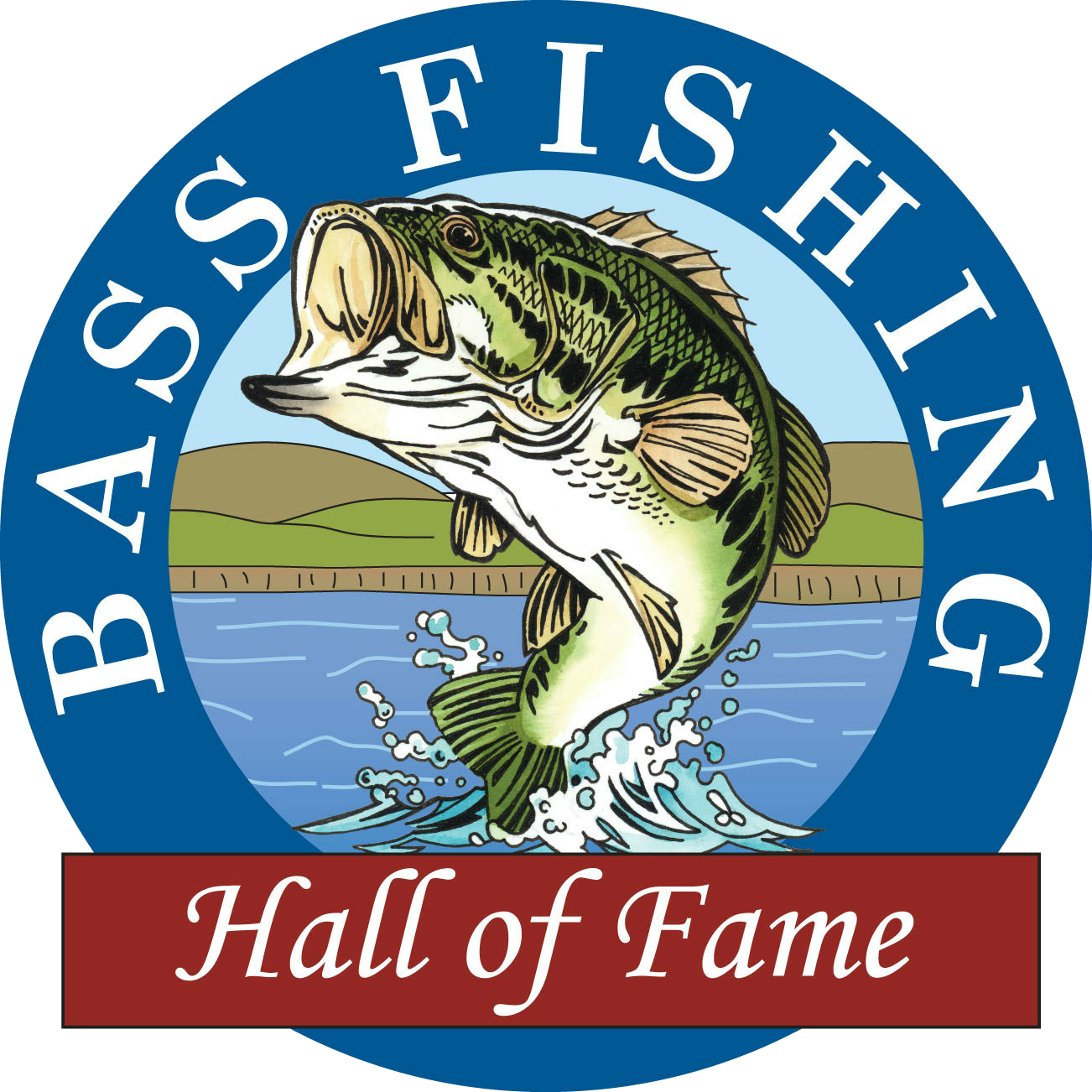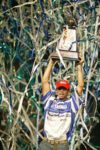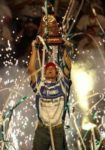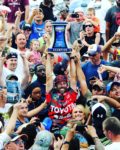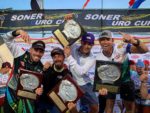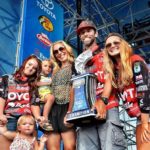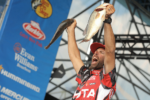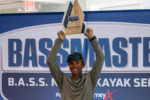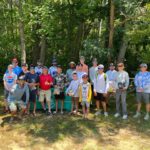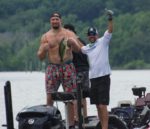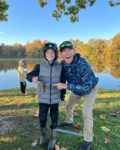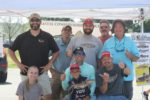Alfred Williams
Racial desegregation may have been mandated by federal laws and court rulings in the 1950s and ’60s, but in reality, almost insurmountable barriers between the races continued to exist across the South, especially in the Jackson, Mississippi, area where Alfred Williams grew up.
If any barriers existed in the world of bass fishing, Williams quietly and confidently overcame them. After returning from a tour in the Vietnam War, he began fishing bass tournaments, often as the only Black competitor, and winning way more than his share. He joined a local B.A.S.S. Nation bass club, made the Mississippi state team, and then won the 1983 Bassmaster Classic divisional qualifier on Ross Barnett Reservoir.
Williams earned a berth in the Classic that year on the Ohio River at Cincinnati, Ohio, making history as the first Black angler ever to qualify for the prestigious championship. He finished 10th out of 42 contenders, ranking ahead of Hank Parker, Rick Clunn, Denny Brauer and Roland Martin.
His success attracted many more African-American anglers to bass fishing and paved the way for Ish Monroe, Mark Daniels Jr. and other Black pro anglers to follow.
Williams also has made a difference in bass fishing in ways unrelated to race. He is credited with popularizing the use of hollow-body frogs, which accounted for many of his 200 tournament victories on Ross Barnett.
He added weight to his favorite Snag Proof models to make them rider lower in the water and dramatically improve hook-setting success. He drew more strikes by adding a rattle chamber to the belly and replacing the stock rubber legs with spinnerbait skirts. Snag Proof incorporated his custom alterations in certain tournament models of its frogs.
Over his long career, Williams competed in nearly 300 BASSMASTER and FLW events, winning four pro-level contests and earning numerous Top 10s.
He continues to serve as a mentor and role model to other Black anglers in his home state and throughout the nation.
Alfred Williams
Mark Zona grew up in a southern suburb of Chicago. He caught his first bass at the age of 4 when his parents traveled to Sturgis, Michigan on a family vacation. That first bass sparked an immediate passion for fishing and set the trajectory of his life.
In 1982 at the age of 9 he fished and won his first ever bass fishing tournament splitting $2,200 with his partner. The fishing bug was on overdrive from that point forward. After graduating from Homewood Flossmor High School Zona immediately moved back to Sturgis, MI where his parents had bought a house on Klinger Lake. He attended Glen Oaks Community College while also fishing local and regional bass fishing tournaments.
After college he began selling pontoon and bass boats while still competing in local tournaments and eventually moving on to the national level which included the Bassmaster Invitationals and Opens, and the FLW Everstart Northern Division, where he won the division’s AOY in 2003.
Around that time he and his wife Karin seriously considered a full time move into tour level fishing but then an opportunity to interview with ESPN for their new outdoor Bass Saturday block arrived. Zona landed the position and became the co-host of a show called Loudmouth Bass in 2004. This was the beginning of his new life as a television commentator, host and analyst.
In 2005 ESPN scaled down their outdoor programming but kept Zona on as the host of his own fishing show named “World’s Greatest Fishing Show “which aired for four years. When ESPN transitioned out of outdoor programming in 2009 Zona continued with his fishing show but renamed it “Zona’s Awesome Fishing Show!” and began airing it exclusively on the Outdoor Channel and World Fishing Network. Zona’s show is currently still in production and has become one of the most popular bass fishing shows in the history of outdoor television winning multiple Golden Moose awards. Expanding outside of television Zona also began hosting a live internet fishing show called “ZONA LIVE” which aired on Bassmaster.com and YouTube. ZONA LIVE along with “Zona Unplugged” and “Zona Show Dirt” have generated over 15 million views on his YouTube channel.
In 2005 in addition to hosting his own show Zona’s extensive knowledge of professional bass fishing caught the eye of Jerry and Mike McKinnis who invited him to co-host The Bassmaster Show with Tommy Sanders. What was initially thought to be a one time occurrence has become a multi decade long career. Zona has been with B.A.S.S. through the inception of Bassmaster LIVE which launched at the 2015 Classic on Lake Hartwell, bringing reality to the long dreamed concept of truly live on-the-water tournament coverage.
Zona’s work on outdoor television has included BassCenter, The Greatest Angler Debate, The Bass Pros, Pro Team Journal by Strike King, Strike King’s Fish Hard, Kings of Bass, College Smash-Mouth Bass Championship, Oberta Redfish Cup, The World’s Greatest Fishing Show, Zona’s Awesome Fishing Show, Zona Live, as well as appearing in the movie Bait Shop.
He has appeared on ESPN, FOX, FS1, The Outdoor Channel, World Fishing Network,MyOutdoorTV, HULU, Amazon Prime Video, Bassmaster.com, YouTube, and many more platforms. His passionate style and love for fishing has entertained millions of fishing fans and brought countless new fans into the sport.
Mark Zona
Mike Iaconelli – 1972) — A one-of-a-kind angler from New Jersey, Mike Iaconelli has brought an urban flair to a sport traditionally ruled by southern anglers.
He is the only angler in history to have won the B.A.S.S. Federation National title (1999), the Bassmaster Classic (2003), the Bassmaster Elite Series Angler of the Year title (2006) and the B.A.S.S. Nation Kayak Series Champion (2021). An 11-time winner across Bassmaster and FLW/MLF events with more than $3 million in earnings over his 25-plus year career, Iaconelli has left an indelible mark on the sport both on and off the water.
Iaconelli grew up taking fishing trips to the Pocono Mountains with his grandfather and uncle and developed a deep passion for bass fishing in his teens and college years. He worked for a national sporting goods retailer for several years while at the same time competing in amateur tournaments around the northeast.
He’s been a transcendent personality and fan favorite over the years but his brash tactics early in career ran afoul of some of the sport’s traditional norms. The phrase “never give up” became a mantra for Iaconelli during his ’03 Classic win and “Going Ike” is often used to describe his (and others’) wild reactions after landing fish.
Few anglers have been able to parlay their fishing success into building a personal brand in the way Iaconelli has. In the wake of his Classic win, he made frequent appearances on ESPN talk shows and was profiled in GQ, Esquire and ESPN: The Magazine. He’s hosted fishing TV shows that highlighted fishing opportunities that exist in urban areas, helping expose a broader, mainstream audience to bass fishing
He is co-founder of The Bass University, a vast series of seminars and instructional materials featuring other pro anglers who serve as speakers/instructors, as well as the host of the popular Ike Live podcast. Alongside his wife, Becky, Iaconelli operates The Ike Foundation, a non-profit organization that raises funds and engages youth anglers through events and scholarships.
Mike Iaconelli
Bruce Holt (1948 – 2021) So many aspects of the bass fishing industry have seen success over the years due to efforts from people like Bruce Holt. While he fished local bass tournaments and promoted the sport in nearly everything he did, his involvement on the ‘business’ side is what qualifies him for induction into the Bass Fishing Hall of Fame. His contacts with the industry led to the success of G. Loomis Rods – he identified up-and-coming pro anglers and his support to them led to success in their careers – his life and career mirrors the mission of the BFHOF – celebrating, promoting and preserving the sport of bass fishing.
Bruce was involved in the fishing industry for nearly 45 years prior to passing in 2021 after his battle with cancer. He was a quiet, yet very influential force within the bass fishing world in roles that spanned the gamut – senior executive with an international fishing rod brand where he was also involved with bass rod research and development, writer and photographer with credits in leading media outlet, and was known for uncovering key bass waters – El Salto in Mexico, Choke Canyon in Texas, Peacock bass in the Amazon, and the smallmouth-filled waters of the Columbia River to name a few – that over the years became well-known from the ‘fam trips’ he organized with bass fishing media from around the globe.
Through his 34-year career with G. Loomis Rods, Bruce had a key role in the manufacturer’s rise to being one of the world’s most highly respected, high-performance rod makers. An avid bass angler, Holt played a large part as G. Loomis expanded its salmon and steelhead rod roots from being located in the Pacific Northwest to a major emphasis on the bass fishing market. He contributed to G. Loomis’ success in numerous positions over the years, from being in charge of sales and marketing before Shimano’s acquisition of the company in 1997, to a nearly a decade-long stint as executive director and then returning to his media communications and public relations role during his last decade with the company.
During the early days in the growth of professional bass fishing circuits, Bruce identified and supported many upcoming anglers, including Ricky Green, Greg Hackney, Luke Claussen, David Walker and Mark Rose who have all found success in the pro ranks. He further gave back to the industry by serving on Bass Fishing Hall of Fame Board of Directors for 10-plus years, including being the Board vice president during major decisions about the Hall’s future.
Bruce Holt
Glen Andrews – From 1962 to 1966, Glen Andrews, of Lead Hill, Ark., won three Missouri State Championships, an Arkansas State Championship, was the runner up twice in the World Championship, followed by two World Championships. Those World Championships, formally known as World Series of Sportfishing, were the first national fishing contests combining anglers from all over the country. Andrews was the only angler to win two of those titles. In all of those events he never made a single dollar in prize money. But his reputation, guide and lure business were flying high. He had helped develop and was the first man to market what is now known as the Texas Rig. In the 1960s, it was the Andrews Slip-Sinker Worm.
He has been called many times the ‘best bass angler’ to ever live from the likes of Bass Fishing Hall of Famers, Bill Dance, Bobby Murray, Jerry McKinnis, and Ray Scott. Many of today’s heroes were mentored by him, including Dance and Murray.
His impact, though, was even greater. Without Andrews’ experience and reputation, the All American on Beaver Lake in 1967 would have never gotten off the ground. Local supporters of the All American would not sign off on the event unless Andrews gave it his blessing. Once blessed, Andrews used his contacts to help Ray Scott fill the field with anglers ready to travel and compete.
He was the Rules Chairman for Ray Scott in that first event and helped forge the strict rules that all tournament anglers live by today and for good reason. In those early World Championships, rules often changed sometimes day to day to keep Andrews from winning.
Here’s a link with more to read to see why those rules were so integral to the game we love today – https://www.bassfishinghof.com/glen-andrews
Glen Andrews
Lonnie Stanley — Texas legend Lonnie Stanley is the owner and creator of Stanley Lures, one of the most popular lure companies of the 1980s and beyond. His jigs and spinnerbaits became the must-have lures of that period, largely because of his success with them on the Bassmaster Tournament Trail and his passion for teaching others how to fish jigs and spinnerbaits properly. He fished 124 B.A.S.S. events, made five Bassmaster Classic appearances, won one tournament and finished in the Top 10 a total of 13 times. Stanley co-hosted ESPN’s “Sportsmen’s Challenge” show for 18 years and was inducted into the Texas Freshwater Hall of Fame in 2012.
